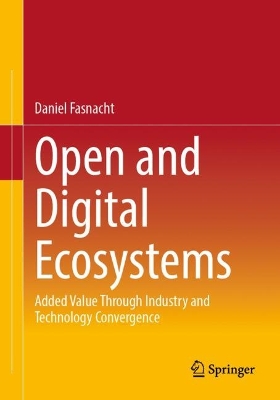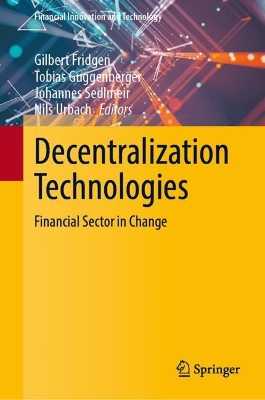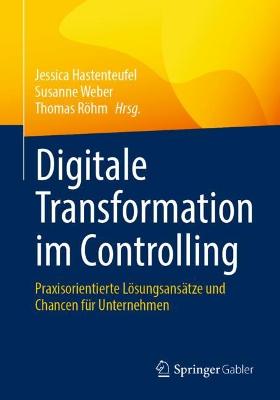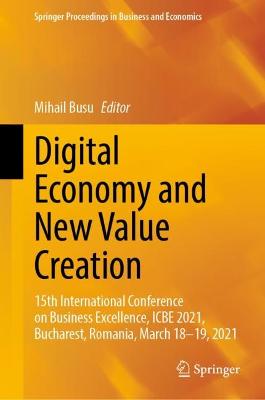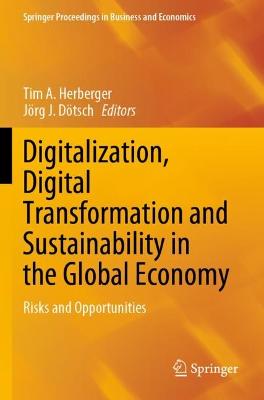Finance and Law in the Metaverse World
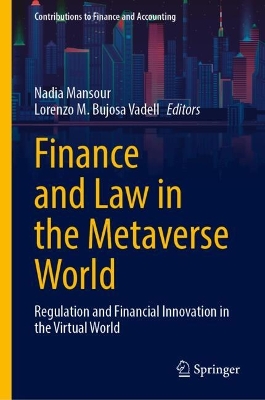 portes grátis
portes grátis
Finance and Law in the Metaverse World
Regulation and Financial Innovation in the Virtual World
Mansour, Nadia; Bujosa Vadell, Lorenzo M.
Springer International Publishing AG
12/2024
674
Dura
9783031675461
Pré-lançamento - envio 15 a 20 dias após a sua edição
Descrição não disponível.
Chapter 1. Systematic Literature Review on WAQF Issues and Challenges to Sustain the WAQF Development Initiatives.- Chapter 2. Echoes of Silence: the Complex Dynamics of Reporting Incest.- Chapter 3. Mass Customization in Welding and Manufacturing Through Standard Work Hours (SWH) Modelling.- Chapter 4. Behind the Screen: Exploring Cybersex Addiction as the Mediator of Factors Influence and Its Psychological and Physical in Peninsular Malaysia.- Chapter 5. Are Independent and Nonexecutive Directors Improving Corporate Governance and Firm Performance: An Evidence From Bangladesh.- Chapter 6. Integrating Sustainability Into Software Development: A Global Categorization.- Chapter 7. Mediating Effects of Strategic Outsourcing on the Relationship Between Supply Chain Complexity and Supply Chain Performance.- Chapter 8. Understanding Binary Employees' Awareness Towards LGBTQ Inclusion at Workplaces.- Chapter 9. Machine Learning-based Models for the Pre-emptive Diagnosis of Sickle Cell Anemia Using Clinical Data.- Chapter 10. Using Digital Visualization Tools to Explore Landscape Preferences of Young Generation to Improve Youth Well-being in Residential Communities.- Chapter 11. Islamic Economics and Finance.- Chapter 12. Improving State Management of Agricultural Production Development in the Digital Economy.- Chapter 13. Towards a Knowledge-based Economy: Empowering Higher Education in Oman With Ai for Vision 2040 Achievement.- Chapter 14. The Impact of Internal Auditors' Application for Information Technology Requirements on the Audit of Internal Control Systems of Banks - (an Applied Study on a Sample of the Banking Sector in UAE - 2024 ).- Chapter 15. Students' Mental Health and Sustainable Learning Practices in Saudi Arabia.- Chapter 16. Synergies of Design Thinking, Lean, and Agile Methodologies in UAE SME Success.- Chapter 17. Evaluation of the Innovation Capability Toward Business Sustainability in the West Java Creative Market.- Chapter 18. Enhancing House Price Prediction Accuracy and Preci-sion: A Data Mining Approach With Python and Stacking Algorithm.- Chapter 19. Towards an Effective Student Bodies and Students' Movement.- Chapter 20. Enhancing the Performance of Translation Graduates Through Training: a Proposed Practical Model.- Chapter 21. Revolutionizing Employee File Management: Can Ejada Lead the Digital Transformation.- Chapter 22. Urban Mobility Planning and Path Optimization in Mo-bility as a Service (MaaS) Using Machine Learning.- Chapter 23. Green Minds, Green Future: Impact of Environmental Education on Students' Attitudes and Intentions.- Chapter 24. An Interplay of Artificial Intelligence Based Customer Analysis on the Performance of Customer Relationship Management in Organized Retail Outlets -serial Mediation Approach.- Chapter 25. An Analytical Framework for Improving Employee Assistance Program Implementation in Organizations.- Chapter 26. Leveraging Retail Business Outcomes: the Influence of Artificial Intelligence in ERP Systems on End Users.- Chapter 27. A Study on Relationship Between Awareness, Attitude and Satisfaction of Sustainable Farmers in Sustainable Farming Through Structural Equation Modelling.- Chapter 28. E-mail Classification Using Traditional Deep Learning Models & Large Language Models (LLMs).- Chapter 29. The Rise of the Metaverse: a Paradigm Shift in Marketing.- Chapter 30. The Influence of Mother's Role in Strengthening Millennial Perceptions of Gender Intelligence.- Chapter 31. The Influence of Sustainable Human Resource Practices on Employee Retention.- Chapter 32. Beyond Bloodlines: Understanding the Deep-seated Forces Fueling Incestuous Dynamics.- Chapter 33. Consumers' Intentions to Utilize Service Robots in Restaurants and Cafes: Why Some Embrace, While Others Avoid.- Chapter 34. Determinants Factors of Skincare Brand Loyalty Among Gen Z in Jakarta.- Chapter 35. Information and Communication Support for the Diversification of Business Processes in Conditions of Global Financial Uncertainty.- Chapter 36. Navigating the Future: Exploring Fintech's Strategic Impact, Competitiveness, and Sustainability (A Conceptual Review).- Chapter 37. Designing a Digital Platform for the Umrah Ecosystem: A Conceptual Analysis and Design Thinking Approach.- Chapter 38. Socio- Demographic Variables Affecting the Occupational Stress of Senior Secondary School Teachers in Himachal Pradesh.- Chapter 39. AI in IA: Impact of Artificial Intelligence in Internal Audit - a Qualitative Study.- Chapter 40. Navigating the Road to Safety: A Comprehensive Analysis on Level of Enhancing Road Safety Among Motorcyclists in Selangor.- Chapter 41. Using Information and Communication Technology for Smart Urban Governance Mediated by Community Engagement.- Chapter 42. The Effect of Academics' Openness to Experience Trait on the Behavior of Sharing Knowledge Voluntarily in Bahrain's HEIs.- Chapter 43. Capability Modeling in Enterprise Process Map for IT Industry.- Chapter 44. Evaluating the Reliability and Impact of Ai-assisted Tools on Argumentative Writing Competency Among EFL Omani Learners.- Chapter 45. Exploring the Role of Generative AI Awareness in Shaping Student ?perceptions.- Chapter 46. Machine Learning Solutions for Sustainable Rambutan Farming: A Needs Assessment for Disease Detection.- Chapter 47. Utilizing the Business Model Canvas for Sustainable Practices Thailand's Food Industry Business Model: A Systematic Approach.- Chapter 48. Developing a Model of Content Marketing in Creative Economy Marketing Strategies to Influence Consumer Purchase Intentions.- Chapter 49. Enhancing Cybersecurity Through Continuous Authentication: a Review of Keystroke and Mouse Dynamics.- Chapter 50. Social and Environmental Protection in Islamic Social Enterprise: a Proposed Model for Sustainability.- Chapter 51. Blockchain Proposal for Productive Zakat to Boost the Performance of Smes in Buraimi, Sultanate of Oman: an Exploratory Study.- Chapter 52. Impact of Binge-watching, Bedtime Procrastination, and Social Media Use on Imposter Phenomenon Among Young Adults.- Chapter 53. Assessing Critical Success Factors of Business Continuity During Pandemic: Case Study From Bahrain's Financial Sector.- Chapter 54. A Systematic Literature Review on the Impact of Business Intelligence Systems in Monitoring Customer Churn in the Insurance Sector.- Chapter 55. From on-board Data to Network Knowledge: A Group-based Federated Learning Approach for Vehicular Networks.- Chapter 56. Truth in the Time of AI: Strategies for Countering Fake News in Social Media Landscapes.- Chapter 57. A Sequential Mixed Method Approach to Measure Internal Audit Effectiveness.- Chapter 58. Comparison of Online Shopping in the Visegrad Group ?and Scandinavian Countries.
Este título pertence ao(s) assunto(s) indicados(s). Para ver outros títulos clique no assunto desejado.
Finance;Regulation;Metaverse;Innovation;Digital Transformation;Digitalization;Digital Technology;Virtual World;E-Finance;Digital Currencies;Alternative Finance;Digital Platforms;AI;Cryptocurrencies;Cloud Accounting;Smart Contracts;Blockchain
Chapter 1. Systematic Literature Review on WAQF Issues and Challenges to Sustain the WAQF Development Initiatives.- Chapter 2. Echoes of Silence: the Complex Dynamics of Reporting Incest.- Chapter 3. Mass Customization in Welding and Manufacturing Through Standard Work Hours (SWH) Modelling.- Chapter 4. Behind the Screen: Exploring Cybersex Addiction as the Mediator of Factors Influence and Its Psychological and Physical in Peninsular Malaysia.- Chapter 5. Are Independent and Nonexecutive Directors Improving Corporate Governance and Firm Performance: An Evidence From Bangladesh.- Chapter 6. Integrating Sustainability Into Software Development: A Global Categorization.- Chapter 7. Mediating Effects of Strategic Outsourcing on the Relationship Between Supply Chain Complexity and Supply Chain Performance.- Chapter 8. Understanding Binary Employees' Awareness Towards LGBTQ Inclusion at Workplaces.- Chapter 9. Machine Learning-based Models for the Pre-emptive Diagnosis of Sickle Cell Anemia Using Clinical Data.- Chapter 10. Using Digital Visualization Tools to Explore Landscape Preferences of Young Generation to Improve Youth Well-being in Residential Communities.- Chapter 11. Islamic Economics and Finance.- Chapter 12. Improving State Management of Agricultural Production Development in the Digital Economy.- Chapter 13. Towards a Knowledge-based Economy: Empowering Higher Education in Oman With Ai for Vision 2040 Achievement.- Chapter 14. The Impact of Internal Auditors' Application for Information Technology Requirements on the Audit of Internal Control Systems of Banks - (an Applied Study on a Sample of the Banking Sector in UAE - 2024 ).- Chapter 15. Students' Mental Health and Sustainable Learning Practices in Saudi Arabia.- Chapter 16. Synergies of Design Thinking, Lean, and Agile Methodologies in UAE SME Success.- Chapter 17. Evaluation of the Innovation Capability Toward Business Sustainability in the West Java Creative Market.- Chapter 18. Enhancing House Price Prediction Accuracy and Preci-sion: A Data Mining Approach With Python and Stacking Algorithm.- Chapter 19. Towards an Effective Student Bodies and Students' Movement.- Chapter 20. Enhancing the Performance of Translation Graduates Through Training: a Proposed Practical Model.- Chapter 21. Revolutionizing Employee File Management: Can Ejada Lead the Digital Transformation.- Chapter 22. Urban Mobility Planning and Path Optimization in Mo-bility as a Service (MaaS) Using Machine Learning.- Chapter 23. Green Minds, Green Future: Impact of Environmental Education on Students' Attitudes and Intentions.- Chapter 24. An Interplay of Artificial Intelligence Based Customer Analysis on the Performance of Customer Relationship Management in Organized Retail Outlets -serial Mediation Approach.- Chapter 25. An Analytical Framework for Improving Employee Assistance Program Implementation in Organizations.- Chapter 26. Leveraging Retail Business Outcomes: the Influence of Artificial Intelligence in ERP Systems on End Users.- Chapter 27. A Study on Relationship Between Awareness, Attitude and Satisfaction of Sustainable Farmers in Sustainable Farming Through Structural Equation Modelling.- Chapter 28. E-mail Classification Using Traditional Deep Learning Models & Large Language Models (LLMs).- Chapter 29. The Rise of the Metaverse: a Paradigm Shift in Marketing.- Chapter 30. The Influence of Mother's Role in Strengthening Millennial Perceptions of Gender Intelligence.- Chapter 31. The Influence of Sustainable Human Resource Practices on Employee Retention.- Chapter 32. Beyond Bloodlines: Understanding the Deep-seated Forces Fueling Incestuous Dynamics.- Chapter 33. Consumers' Intentions to Utilize Service Robots in Restaurants and Cafes: Why Some Embrace, While Others Avoid.- Chapter 34. Determinants Factors of Skincare Brand Loyalty Among Gen Z in Jakarta.- Chapter 35. Information and Communication Support for the Diversification of Business Processes in Conditions of Global Financial Uncertainty.- Chapter 36. Navigating the Future: Exploring Fintech's Strategic Impact, Competitiveness, and Sustainability (A Conceptual Review).- Chapter 37. Designing a Digital Platform for the Umrah Ecosystem: A Conceptual Analysis and Design Thinking Approach.- Chapter 38. Socio- Demographic Variables Affecting the Occupational Stress of Senior Secondary School Teachers in Himachal Pradesh.- Chapter 39. AI in IA: Impact of Artificial Intelligence in Internal Audit - a Qualitative Study.- Chapter 40. Navigating the Road to Safety: A Comprehensive Analysis on Level of Enhancing Road Safety Among Motorcyclists in Selangor.- Chapter 41. Using Information and Communication Technology for Smart Urban Governance Mediated by Community Engagement.- Chapter 42. The Effect of Academics' Openness to Experience Trait on the Behavior of Sharing Knowledge Voluntarily in Bahrain's HEIs.- Chapter 43. Capability Modeling in Enterprise Process Map for IT Industry.- Chapter 44. Evaluating the Reliability and Impact of Ai-assisted Tools on Argumentative Writing Competency Among EFL Omani Learners.- Chapter 45. Exploring the Role of Generative AI Awareness in Shaping Student ?perceptions.- Chapter 46. Machine Learning Solutions for Sustainable Rambutan Farming: A Needs Assessment for Disease Detection.- Chapter 47. Utilizing the Business Model Canvas for Sustainable Practices Thailand's Food Industry Business Model: A Systematic Approach.- Chapter 48. Developing a Model of Content Marketing in Creative Economy Marketing Strategies to Influence Consumer Purchase Intentions.- Chapter 49. Enhancing Cybersecurity Through Continuous Authentication: a Review of Keystroke and Mouse Dynamics.- Chapter 50. Social and Environmental Protection in Islamic Social Enterprise: a Proposed Model for Sustainability.- Chapter 51. Blockchain Proposal for Productive Zakat to Boost the Performance of Smes in Buraimi, Sultanate of Oman: an Exploratory Study.- Chapter 52. Impact of Binge-watching, Bedtime Procrastination, and Social Media Use on Imposter Phenomenon Among Young Adults.- Chapter 53. Assessing Critical Success Factors of Business Continuity During Pandemic: Case Study From Bahrain's Financial Sector.- Chapter 54. A Systematic Literature Review on the Impact of Business Intelligence Systems in Monitoring Customer Churn in the Insurance Sector.- Chapter 55. From on-board Data to Network Knowledge: A Group-based Federated Learning Approach for Vehicular Networks.- Chapter 56. Truth in the Time of AI: Strategies for Countering Fake News in Social Media Landscapes.- Chapter 57. A Sequential Mixed Method Approach to Measure Internal Audit Effectiveness.- Chapter 58. Comparison of Online Shopping in the Visegrad Group ?and Scandinavian Countries.
Este título pertence ao(s) assunto(s) indicados(s). Para ver outros títulos clique no assunto desejado.


